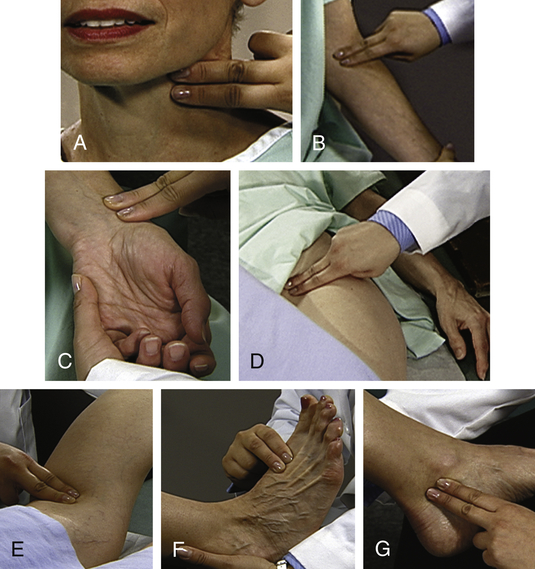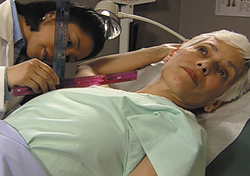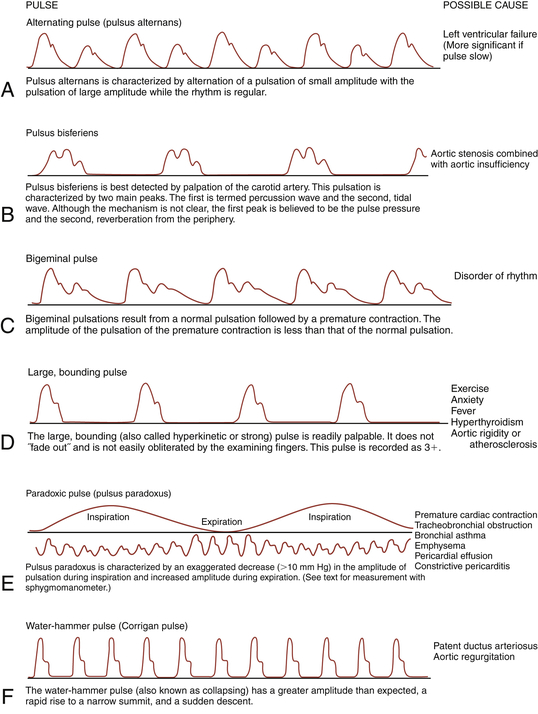Blood Vessels
Examination
Technique
Findings
Peripheral Arteries
Palpate arterial pulses in neck and extremities
Palpate carotid, brachial, radial, femoral, popliteal, dorsalis pedis, and posterior tibial arteries, using distal pads of second and third fingers, as shown in figures below and on p. 117.
EXPECTED: Femoral pulse as strong as or stronger than radial pulse.
UNEXPECTED: Femoral pulse weaker than radial pulse or absent. Alternating pulse (pulsus alternans), pulsus bisferiens, bigeminal pulse (pulsus bigeminus), bounding pulse, labile pulse, paradoxical pulse (pulsus paradoxus), pulsus differens, tachycardia, trigeminal pulse (pulsus trigeminus), or water-hammer pulse (Corrigan pulse).

EXPECTED: 60-90 beats/min.
UNEXPECTED: Rate different from that observed during cardiac examination.
EXPECTED: Regular.
UNEXPECTED: Irregular, either in a pattern or patternless.
EXPECTED: Smooth, rounded, or dome-shaped.
UNEXPECTED: Bounding, full, diminished, or absent. Describe on scale of 0-4:
Auscultate carotid and subclavian arteries; abdominal aorta; and renal, iliac, and femoral arteries for bruits
When auscultating the carotid vessels, you may at times need to ask patient to hold breath for a few heartbeats. Auscultate with bell of stethoscope.
UNEXPECTED: Transmitted murmurs, bruits.
Assess for arterial occlusion and insufficiency
UNEXPECTED: Dull ache accompanied by fatigue and often cramping; possible constant or excruciating pain. Weak, thready, or absent pulses; systolic bruits over arteries; loss of body warmth; localized pallor or cyanosis; delay in venous filling; or thin, atrophied skin, muscle atrophy, and loss of hair.
EXPECTED: Slight pallor on elevation and return to full color as soon as leg becomes dependent.
UNEXPECTED: Delay of >2 sec.
Measure blood pressure
Measure in both arms at least once. Patient’s arm should be slightly flexed and comfortably supported on table, pillow, or your hand.
EXPECTED: <120 mm Hg systolic and <80 mm Hg diastolic, with pulse pressure of 30-40 mm Hg (sometimes to 50 mm Hg). Reading between arms may vary by as much as 10 mm Hg. Prehypertension is now defined as a blood pressure between 120 and 139 mm Hg systolic or 80 and 89 mm Hg diastolic.
UNEXPECTED: Hypertension (see Chapter 2).
Peripheral Veins
Assess jugular venous pressure
Ask patient to recline at 45-degree angle. With tangential light, observe the jugular vein. As shown in figure below, use a centimeter ruler to measure vertical distance between midaxillary line and highest level of jugular vein distention.
EXPECTED: Pressure ≤9 cm H2O, bilaterally symmetric.
UNEXPECTED: Abnormal elevation, distention or distention on one side. 
Assess for venous obstruction and insufficiency
Inspect extremities, with patient both standing and supine.
![]()
Stay updated, free articles. Join our Telegram channel

Full access? Get Clinical Tree

 Get Clinical Tree app for offline access
Get Clinical Tree app for offline access

Blood Vessels
Get Clinical Tree app for offline access
